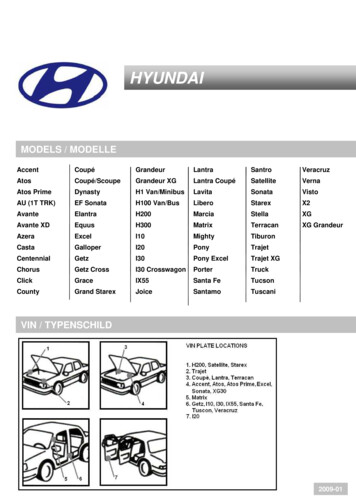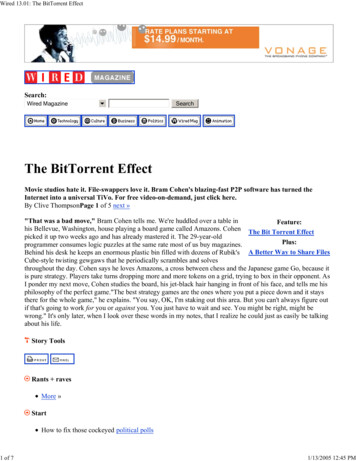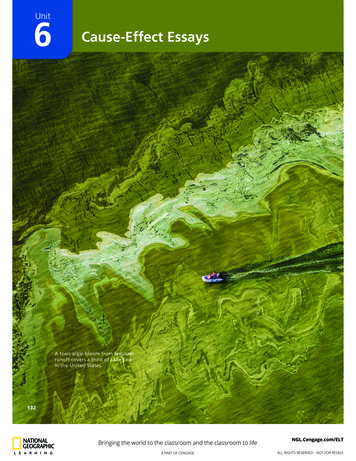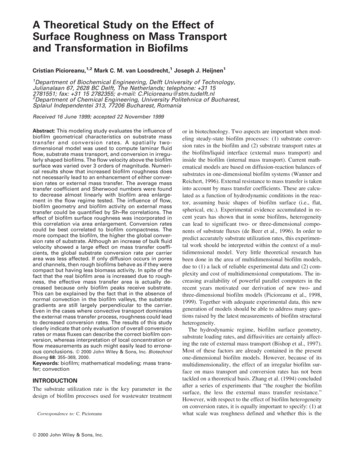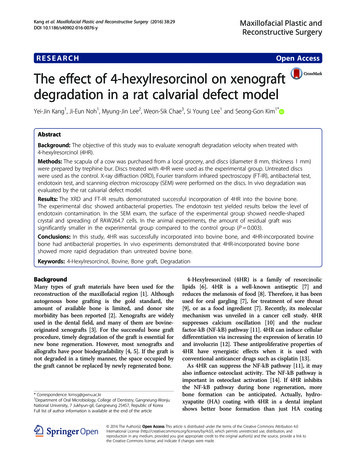
Transcription
Kang et al. Maxillofacial Plastic and Reconstructive Surgery (2016) 38:29DOI 10.1186/s40902-016-0076-yMaxillofacial Plastic andReconstructive SurgeryRESEARCHOpen AccessThe effect of 4-hexylresorcinol on xenograftdegradation in a rat calvarial defect modelYei-Jin Kang1, Ji-Eun Noh1, Myung-Jin Lee2, Weon-Sik Chae3, Si Young Lee1 and Seong-Gon Kim1*AbstractBackground: The objective of this study was to evaluate xenograft degradation velocity when treated with4-hexylresorcinol (4HR).Methods: The scapula of a cow was purchased from a local grocery, and discs (diameter 8 mm, thickness 1 mm)were prepared by trephine bur. Discs treated with 4HR were used as the experimental group. Untreated discswere used as the control. X-ray diffraction (XRD), Fourier transform infrared spectroscopy (FT-IR), antibacterial test,endotoxin test, and scanning electron microscopy (SEM) were performed on the discs. In vivo degradation wasevaluated by the rat calvarial defect model.Results: The XRD and FT-IR results demonstrated successful incorporation of 4HR into the bovine bone.The experimental disc showed antibacterial properties. The endotoxin test yielded results below the level ofendotoxin contamination. In the SEM exam, the surface of the experimental group showed needle-shapedcrystal and spreading of RAW264.7 cells. In the animal experiments, the amount of residual graft wassignificantly smaller in the experimental group compared to the control group (P 0.003).Conclusions: In this study, 4HR was successfully incorporated into bovine bone, and 4HR-incorporated bovinebone had antibacterial properties. In vivo experiments demonstrated that 4HR-incorporated bovine boneshowed more rapid degradation than untreated bovine bone.Keywords: 4-Hexylresorcinol, Bovine, Bone graft, DegradationBackgroundMany types of graft materials have been used for thereconstruction of the maxillofacial region [1]. Althoughautogenous bone grafting is the gold standard, theamount of available bone is limited, and donor sitemorbidity has been reported [2]. Xenografts are widelyused in the dental field, and many of them are bovineoriginated xenografts [3]. For the successful bone graftprocedure, timely degradation of the graft is essential fornew bone regeneration. However, most xenografts andallografts have poor biodegradability [4, 5]. If the graft isnot degraded in a timely manner, the space occupied bythe graft cannot be replaced by newly regenerated bone.* Correspondence: kimsg@gwnu.ac.kr1Department of Oral Microbiology, College of Dentistry, Gangneung-WonjuNational University, 7 Jukhyun-gil, Gangneung 25457, Republic of KoreaFull list of author information is available at the end of the article4-Hexylresorcinol (4HR) is a family of resorcinoliclipids [6]. 4HR is a well-known antiseptic [7] andreduces the melanosis of food [8]. Therefore, it has beenused for oral gargling [7], for treatment of sore throat[9], or as a food ingredient [7]. Recently, its molecularmechanism was unveiled in a cancer cell study. 4HRsuppresses calcium oscillation [10] and the nuclearfactor-kB (NF-kB) pathway [11]. 4HR can induce cellulardifferentiation via increasing the expression of keratin 10and involucrin [12]. These antiproliferative properties of4HR have synergistic effects when it is used withconventional anticancer drugs such as cisplatin [13].As 4HR can suppress the NF-kB pathway [11], it mayalso influence osteoclast activity. The NF-kB pathway isimportant in osteoclast activation [14]. If 4HR inhibitsthe NF-kB pathway during bone regeneration, morebone formation can be anticipated. Actually, hydroxyapatite (HA) coating with 4HR in a dental implantshows better bone formation than just HA coating 2016 The Author(s). Open Access This article is distributed under the terms of the Creative Commons Attribution 4.0International License (http://creativecommons.org/licenses/by/4.0/), which permits unrestricted use, distribution, andreproduction in any medium, provided you give appropriate credit to the original author(s) and the source, provide a link tothe Creative Commons license, and indicate if changes were made.
Kang et al. Maxillofacial Plastic and Reconstructive Surgery (2016) 38:29Page 2 of 9without 4HR [15]. As osteoclasts are also a type ofmultinucleated cell, 4HR can suppress formation ofmultinucleated cells [16]. This action is helpful for theinhibition of the reaction to foreign bodies induced bysilk materials and results in better bone formation [16].Silk is a poorly degradable material when it is implantedin the body [17]. 4HR also accelerates degradation of silkgraft materials [16, 17].Collectively, xenografts treated with 4HR have beenshown to suppress the reaction to foreign bodies and topromote rapid degradation of poorly biodegradablematerials. The objective of this study was to evaluatexenograft degradation velocity upon treatment with 4HR.The control disc and experimental disc were placed onthe surface of blood agar plates (Hangang, Gunpo-si,Korea) for S. sanguinis and S. aureus and BHI plates forA. actinomycetemcomitans. For comparison, two different types of antibiotic discs (vancomycin and penicillin)were also used. The plates of S. sanguinis and A. actinomycetemcomitans were incubated at 37 C aerobicallysupplemented with 5 % CO2 for 2 days. For S. aureus,the plates were incubated at 37 C aerobically for 1 day.The maximum diameter of the inhibition zone wasobserved.MethodsThe specimens were coated with 0.7 nm of OsO4 (HPC1SW, Japan). Each specimen was observed using a scanning electron microscope (Hitachi, SU-70) and underwent EDX microanalysis (EDAX Genesis; Pv 77, EDAX,USA) to analyze the elements of the area of interest. Thecompositions of the elements were compared.Murine macrophages from the Cell Bank (RAW264.7;Korean Cell Line Bank No. 40071) were grown on thecontrol and experimental discs. The growth of the cellculture was stopped at 1 h after seeding by fixing thesamples. All materials including raw materials wereprepared for scanning electron microscopic examination.After immobilization of the samples on the plate, eachsample was coated with gold and examined using ascanning electron microscope (H-800, Hitachi, Japan).Graft preparationThe scapula of a cow was purchased from a local grocery.Using trephine bur (diameter 8.0 mm), round bone graftswere cut at a thickness of 1.0 mm. The control bone wasplaced into a conical tube containing a 10 % ethanolsolution, and the experimental bone was placed in a 10 %ethanol and 3 % 4HR solution. These tubes were placedon a rotating machine for 24 h. Then, the grafts wereplaced in the drying oven for 8 h. They were sterilizedwith ethylene oxide gas and stored at room temperaturebefore usage. The weight of dried grafts was measuredand the amount of 4HR incorporation into the experimental bone was between 10 to 15 % by weight.X-ray diffraction, Fourier transform infrared absorbancespectra, and endotoxin testX-ray diffraction (XRD) patterns of the samples werecollected in the range of 10 to 60 (2θ) using a diffractometer (PANalytical, X’Pert Pro MPD) with a Cu-Kα(λ 1.5418 Å) radiation source. Fourier transform infrared (FT-IR) spectrum measurements were carried outusing a Vertex 80 (Bruker Optics, Germany) spectrometercoupled with a Hyperion 3000 (Bruker Optics, Germany)microscope equipped with a germanium attenuated totalreflectance objective lens (ATR 20) and a liquidnitrogen-cooled mercury cadmium telluride detector.An endotoxin test was performed using a commercialkit, and the subsequent procedure was in accord withthe manufacturer’s protocol.Scanning electron microscopic examination with EDXmicroanalysis and cellular attachment assayAnimal experimentThis animal study was approved by IACUC (GWNU2014-14). Seventeen 12-week-old Sprague-Dawley ratswith an average weight of 300 g were used for thisexperiment. A dental-trephine bur was used undercopious saline solution irrigation to form a full-thicknesscalvarial defect. An 8-mm-diameter defect was createdon the rat parietal bone, and the control graft or experimental graft was placed in the defect. The control groupconsisted of eight animals, and the experimental groupincluded nine animals. After the grafting procedure, thepericranium and skin were sutured with 3-0 black silk.The animals were sacrificed 6 weeks after the operation.Histological analysisAntibacterial testTwo oral pathogens (Streptococcus sanguinis, ATCC10556, and Aggregatibacter actinomycetemcomitans,ATCC 33384) and Staphylococcus aureus (ATCC 502A)were used for antibacterial tests. The bacterial strainswere cultured with brain heart infusion (BHI) (Becton,Dickinson and Company, Sparks, MD, USA) brothunder aerobic conditions supplemented with 5 % CO2.S. aureus was also cultured under aerobic conditions.The calvarial samples were subjected to dehydration andembedding. The segments were embedded to show thesagittal sections in paraffin blocks. The paraffin blockswere sliced (5 μm) and stained with hematoxylin andeosin. The detailed staining procedure followed thestandard method in the manufacturer’s manual. Theselected sections were photographed with a digital camera(DP-73; Olympus, Tokyo, Japan). The images were analyzed with Sigma Scan Pro (SPSS, Chicago, IL). The ratio
Kang et al. Maxillofacial Plastic and Reconstructive Surgery (2016) 38:29of the remaining graft was calculated based on the ratioof the remaining graft to the original size of the graft.Statistical analysisAn independent sample t test was used to compare thecontrol and experimental groups in the animal study.The significance level was set at P 0.05.Page 3 of 9Results4HR-incorporated bovine bone had antibacterialpropertiesFigure 1a shows the XRD patterns of the bovine and 4HRtreated bovine samples. The bovine specimenpresents atypical diffraction pattern corresponding to an HA phase(International Center for Diffraction Data (ICDD),003-0747), consisting of calcium hydroxide phosphateFig. 1 a XRD patterns of the bovine and 4-hexylresorcinol (4-HR)-treated bovine samples. b FT-IR spectra
Kang et al. Maxillofacial Plastic and Reconstructive Surgery (2016) 38:29Page 4 of 9components. The observed diffraction peaks were somewhat broadened, indicating low crystallinity. 4HR treatment does not change any diffractions of the bovine.Otherwise, additional narrow diffraction peaks wereobserved in the relatively low angle region, and the patternwas reasonably matched to the reference diffraction of4HR (ICDD, 034-1558). The narrow diffraction peaksimply high crystalline characteristics.As seen in the FT-IR spectra, the bovine sample showsseveral vibrational absorptions: an OH vibration at 13250 cm 1 and a PO3 (Fig. 1b).4 vibration at 1026 cmThe characteristic vibrations of aliphatic hydrocarbons at2800 3000 cm 1 and the vibrational absorptions at 1200 1700 cm 1 are attributed to organic moieties in thebovine samples. The 4HR-treated bovine sample clearlyshows distinctive infrared absorptions corresponding to4HR [18, 19]. The OH and aliphatic hydrocarbon peaksare also strengthened in the region of 2800 to 3600 cm 1.The 1614 and 1525 cm 1 peaks are attributed to aromaticring C-C stretching. The 1217, 1192, and 1171 cm 1absorptions are attributed to C-O stretching. The vibrational absorption at 972 cm 1 is attributed to CH2wagging, and the several absorption peaks at 780 840 cm 1 can be assigned to aromatic C-H bending [19].A subsequent endotoxin assay yielded results of0.04 EU/ml for the control disc and 0.01 EU/ml forFig. 2 Antibacterial test. a S. sanguinis, b S. aureus, andc A. actinomycetemcomitans (PN penicillin, VA vancomycin,4HR 4-hexylresorcinol-incorporated bovine bone). The4-hexylresorcinol-incorporated bovine bone disc inhibitedthe growth of all tested bacteria. Interestingly, vancomycin couldnot inhibit the growth of A. actinomycetemcomitans, while the4-hexylresorcinol-incorporated bovine bone disc showed a similarinhibition level to the penicillin disc (c)Fig. 3 SEM analysis of the graft. The surface of the bovine bone wasgenerally flat with hydroxyapatite crystal and organic material (a).However, the surface of the 4-hexylresorcinol-incorporated bovinebone showed multiple needle-like crystals (b)
Kang et al. Maxillofacial Plastic and Reconstructive Surgery (2016) 38:29Table 1 Composition of elements evaluated by EDXmicroanalysisElementBovine bone4HR treated bovine boneC48.73 2.9062.43 0.46O31.13 2.0527.29 0.23Na0.42 0.03Not detectedMg0.29 0.05Not detectedCa9.51 0.616.40 0.19P5.92 0.383.88 0.09(4HR: 4-hexylresorcinol)the experimental disc. These values were below thelevel of endotoxin contamination ( 0.3 EU/ml).The experimental disc showed a clear bacterial inhibitory zone (Fig. 2). However, the control disc did not haveany inhibitory zones. The experimental disc inhibitedthe growth of all tested bacteria. Interestingly, vancomycin could not inhibit the growth of A. actinomycetemcomitans, while the experimental group showed similarinhibition levels for the penicillin disc.In the SEM analysis, the experimental disc showedneedle-like crystals on its surface (Fig. 3). Resorcinol is aneedle-like crystal that becomes pink upon exposure tolight and air [20]. EDX microanalysis demonstrated thatthe composition of carbon was increased compared tothe untreated control (Table 1). The calcium andPage 5 of 9phosphate contents were also decreased after the 4HRtreatment. RAW264.7 cells on the control disc werespherical and did not spread at 1 h after seeding (Fig. 4).However, RAW264.7 cells were well spread on the 4HRtreated bovine disc. Interestingly, numerous submicronsized processes were observed on the surface of themacrophage.Rapid degradation of 4HR-incorporated bovine bonegraftSerial radiography demonstrated rapid degradation inthe experimental group (Fig. 5). Six of the nine grafts inthe experimental group showed complete degradation at6 weeks after surgery. The grafts started to disappear at3 weeks after surgery. However, all grafts were observedin the control group, and there was no significantchange in size until 6 weeks. When the amount ofresidual graft was compared, the difference between thegroups was statistically significant (Fig. 6; P 0.003).Two animals that received 4HR-incorporated graftsshowed heavy seroma formation on the grafted site. Onewas drained spontaneously, but the other was observeduntil 6 weeks after surgery.Histological exams are shown in Fig. 7. The untreatedcontrol was encapsulated by fibrotic tissue (Fig. 7a). Thesample of the complete degradation of the graft demonstrated an almost complete disappearance of the implantFig. 4 Cellular attachment test. Small, round cells (asterisk) were sporadically attached on the surface of bovine bone (a). Cellular spreading(asterisk) was frequently observed, and multiple round projections on the cellular surface were noticed in the 4-hexylresorcinol-incorporatedbovine bone group (b). High magnification view demonstrated small cells conglomerated each other in the bovine bone group (c). Large cellswith multiple round projections were found in the 4-hexylresorcinol-incorporated bovine bone group
Kang et al. Maxillofacial Plastic and Reconstructive Surgery (2016) 38:29Page 6 of 9Fig. 5 Serial radiograph. The radiograph was taken 1 (W1), 3 (W3), 5 (W5), and 6 (W6) weeks after operation. a The animals received bovine boneimplants (asterisk). All implants were present until 6 weeks after operation. b The animals received 4-hexylresorcinol-incorporated bovine boneimplants (asterisk). Five implants were not observed from 3 weeks after operation (boxed by yellow line)with a well-developed vascular channel in the bonedefect (Fig. 7b). Some samples from the 4HR-treatedgroup showed minimal degradation of the implant(Fig. 7c). Interestingly, some samples from the untreatedgroups showed that the newly regenerated bone was incontact with the graft (Fig. 7d). In the experimentalgroup, there were a few regenerated bones in the defect(Fig. 7e). Loose fibrotic tissue occupied the area ofgrafting. Under high magnification, we observed thatmultinucleated cells encompassed the residual graft(Fig. 7e). There was a rich vascular network around theresidual graft. There were few multinucleated cells. Thesamples with less degradation showed no difference ingross view compared to those in the control group. Underhigh magnification, local resorption with reparative boneregeneration was observed (Fig. 7f). However, multinucleated cells were not observed.DiscussionIn this study, bovine bone obtained from a local grocerywas used for the repair of rat calvarial defect after simpleprocessing. 4HR-treated bovine bone had antibacterialproperties, and RAW264.7 cells were well attached tothe surface of the 4HR-treated bovine bone. 4HR-treatedbovine bone had a higher degradation rate than theuntreated control. However, its degradation velocity was
Kang et al. Maxillofacial Plastic and Reconstructive Surgery (2016) 38:29Fig. 6 The amount of residual graft was evaluated by histologicalview. When compared to the untreated group, the 4HR-treatedgroup showed significantly lower residual grafting (P 0.003)too rapid and did not contribute to new boneregeneration.4HR is a family of hydroxyl phenols [6]. 4HR has two–OH groups. A H ion can be released from –OHgroups of the benzene ring, and the 4HR has acidicproperties [20]. Therefore, the concentration of 4HR inthe bone graft should be carefully monitored. If theconcentration of 4HR is too high and is used for HAbased bone graft materials, H ions released from thegraft would decrease the pH locally and result in massiveloss of calcium from the graft. Although all preparedgraft materials came from the same conical tube, somePage 7 of 9grafts might not have been exposed to 4HR. As a result,there might be a variation in the 4HR concentrationamong grafts. Based on the weight change of the graft,the 4HR concentration of each graft was expected torange from 10 to 15 % by weight. HA incorporating gluconic acid is almost completely degraded 2 weeks aftersurgery [4]. The amount of acid and the release patternwould influence the overall degradation velocity of HA[4]. In a previous study, 3 % wt 4HR in HA or silk wasnot shown to accelerate graft loss [16]. Therefore, lowerconcentration of 4HR should be used for bovine bonegraft in future study.4HR can induce cellular apoptosis dependent on itsconcentration. In the case of epithelial cancer, theapoptosis-inducing concentration is much lower thanthat of the normal dermal fibroblast [12]. As the 4HRconcentrations of grafts were relatively higher than thoseof a previous study [16], high concentrations of 4HRmight induce apoptosis responsible for graft degradationin some cases. Sintered bovine bone graft and syntheticHA are biodegraded by osteoclasts [21] or macrophages[22]. The exact concentration of 4HR required forapoptosis in these cells is yet to be determined. Thebovine bone used for the implant may have been treatedby heat. However, chemically treated bovine bone has better mechanical properties than heat-treated bone [23]. As4HR treatment is a chemical treatment, it would not influence the bone’s original mechanical property.Fig. 7 Histological exam. a The bovine bone implant was encapsulated by a fibrotic capsule, and no sign of degradation was observed. b The animalthat received 4-hexylresorcinol-incorporated bovine bone implants showed little residual grafting and still experienced a large bony defect. New boneformation was observed only in the cutting edge of the calvarial bone. c Another animal bovine bone implant incorporated with 4-hexylresorcinolshowed focal degradation of the graft. Most grafts still occupied the bony defect. d New bone regeneration (asterisk) over the bovine implant wasobserved in some animals that received a bovine bone implant. The regenerated bone directly contacted with the implant (arrow heads). e Highmagnification view of (b). Residual graft was stained with violet color (asterisk), and multinucleated giant cells (arrow heads) were observed. Highlydeveloped vascular channels were also observed. Interestingly, some giant cells appeared to transform into endothelial cells (arrow head). f Highmagnification view of (c). Focal dissolution of implants with reparative calcification was observed
Kang et al. Maxillofacial Plastic and Reconstructive Surgery (2016) 38:29In this study, the control group showed new bonedeposition bordering the graft (Fig. 7d). Mixed bovinebone grafted in the rat calvarial defect was not completely degraded at 9 months, while new bone formationwas observed in the defect border [24]. There was no inflammation around the graft in the control group(Fig. 7a, d). As the control group was only treated with24 h ethanol washing, using a graft material process thatoriginates from bovine bone may be considered in thefuture. The graft materials in this study were sterilizedby ethylene oxide. As demonstrated in the EDX analysisresults, many organic components may remain in thebovine bone. Bio-Oss also has residual proteins [25].The ethylene oxide sterilization does not reduce osteoinductivity of bone morphogenetic proteins [26]. Therefore, bone morphogenetic proteins in the bovine bonewould not be destroyed by ethylene oxide. Only theconcentration of 4HR in the graft appeared to beunknown in this study. The optimal 4HR concentrationfor bone graft should be determined in future studies.ConclusionsIn this study, 4HR was successfully incorporated intobovine bone, and 4HR-incorporated bovine bone had antibacterial property. The in vivo experiment demonstratedthat 4HR-incorporated bovine bone showed more rapiddegradation than untreated bovine bone. However, 4HRincorporated bovine bone graft did not show elevated newbone formation.AcknowledgementsThe authors thank Hyo-Seon Kim and Min-Keun Kim for their help in theexperiments. This work was carried out with the support of “CooperativeResearch Program for Agriculture Science and Technology Development(Project No. PJ01121404)”, Rural Development Administration, Republic ofKorea.Authors’ contributionsKYJ and NJE did most of the experiment and KSG designed this experiment.LMJ and CWS did XRD and FT-IR analysis. LSY did antibacterial test. KSG,CWS, and LSY wrote the manuscript and did critical review on theexperimental process. All authors read and approved the final manuscript.Page 8 of g interestsThe authors declare that they have no competing interests.Author details1Department of Oral Microbiology, College of Dentistry, Gangneung-WonjuNational University, 7 Jukhyun-gil, Gangneung 25457, Republic of Korea.2Gangneung Center, Korea Basic Science Institute, Gangneung 25457,Republic of Korea. 3Analysis Research Division, Daegu Center, Korea BasicScience Institute, Daegu 41566, Republic of Korea.19.20.21.22.Received: 24 May 2016 Accepted: 5 July 201623.References1. Cha HS, Kim JW, Hwang JH, Ahn KM (2016) Frequency of bone graft inimplant surgery. Maxillofac Plast Reconstr Surg 38(1):192. Kim ES, Lee IK, Kang JY, Lee EY (2015) Various autogenous freshdemineralized tooth forms for alveolar socket preservation in anterior toothextraction sites: a series of 4 cases. Maxillofac Plast Reconstr Surg 37(1):2724.Kassim B, Ivanovski S, Mattheos N (2014) Current perspectives on the role ofridge (socket) preservation procedures in dental implant treatment in theaesthetic zone. Aust Dent J 59(1):48–56Sariibrahimoglu K, An J, van Oirschot BA, Nijhuis AW, Eman RM, Alblas J,Wolke JG, van den Beucken JJ, Leeuwenburgh SC, Jansen JA (2014) Tuningthe degradation rate of calcium phosphate cements by incorporatingmixtures of polylactic-co-glycolic acid microspheres and glucono-deltalactone microparticles. Tissue Eng Part A 20(21-22):2870–82Ding X, Takahata M, Akazawa T, Iwasaki N, Abe Y, Komatsu M, Murata M,Ito M, Abumi K, Minami A (2011) Improved bioabsorbability of synthetichydroxyapatite through partial dissolution-precipitation of its surface.J Mater Sci Mater Med 22(5):1247–55Kozubek A, Tyman JH (1999) Resorcinolic lipids, the natural non-isoprenoidphenolic amphiphiles and their biological activity. Chem Rev 99(1):1–26Evans RT, Baker PJ, Coburn RA, Fischman SL, Genco RJ (1977) In vitroantiplaque effects of antiseptic phenols. J Periodontol 48(3):156–62Thepnuan R, Benjakul S, Visessanguan W (2008) Effect of pyrophosphateand 4-hexylresorcinol pretreatment on quality of refrigerated white shrimp(Litopenaeus vannamei) kept under modified atmosphere packaging.J Food Sci 73(3):S124–33McNally D, Shephard A, Field E (2012) Randomised, double-blind,placebo-controlled study of a single dose of an amylmetacresol/2,4-dichlorobenzyl alcohol plus lidocaine lozenge or a hexylresorcinollozenge for the treatment of acute sore throat due to upper respiratorytract infection. J Pharm Pharm Sci 15(2):281–94Kim SG, Choi JY (2013) 4-hexylresorcinol exerts antitumor effects viasuppression of calcium oscillation and its antitumor effects are inhibitedby calcium channel blockers. Oncol Rep 29(5):1835–40Kim SG, Lee SW, Park YW, Jeong JH, Choi JY (2011) 4-hexylresorcinol inhibitsNF-kB phosphorylation and has a synergistic effect with cisplatin in KB cells.Oncol Rep 26(6):1527–32Kim SG, Kim AS, Jeong JH, Choi JY, Kweon H (2012) 4-hexylresorcinolstimulates the differentiation of SCC-9 cells through the suppression ofE2F2, E2F3 and Sp3 expression and the promotion of Sp1 expression. OncolRep 28(2):677–81Lee SW, Kim SG, Park YW, Kweon H, Kim JY, Rotaru H (2013) Cisplatin and 4hexylresorcinol synergise to decrease metastasis and increase survival ratein an oral mucosal melanoma xenograft model: a preliminary study. TumourBiol 34(3):1595–603Abu-Amer Y (2013) NF-kB signaling and bone resorption. Osteoporos Int24(9):2377–86Kim SG, Hahn BD, Park DS, Lee YC, Choi EJ, Chae WS, Baek DH, Choi JY(2011) Aerosol deposition of hydroxyapatite and 4-hexylresorcinol coatingson titanium alloys for dental implants. J Oral Maxillofac Surg 69(11):e354–63Kweon H, Kim SG, Choi JY (2014) Inhibition of foreign body giant cellformation by 4-hexylresorcinol through suppression of diacylglycerol kinasedelta gene expression. Biomaterials 35(30):8576–84Lee SW, Um IC, Kim SG, Cha MS (2015) Evaluation of bone formation andmembrane degradation in guided bone regeneration using a 4hexylresorcinol-incorporated silk fabric membrane. Maxillofac Plast ReconstrSurg 37:32Carver CD (1982) The Coblentz Society Desk Book of Infrared Spectra, 2ndedn. The Coblentz Society, Kirkwood, MOYang WG, Ha JH, Kim SG, Chae WS (2016) Spectroscopic determination of alkylresorcinol concentration in hydroxyapatite composite. J Anal Sci Tech 7:9Durairaj RB (2005) Resorcinol: Chemistry, Technology and Applications.Springer, LeipzigRumpel E, Wolf E, Kauschke E, Bienengräber V, Bayerlein T, Gedrange T,Proff P (2006) The biodegradation of hydroxyapatite bone graft substitutesin vivo. Folia Morphol 65(1):43–8Xia ZD, Zhu TB, Du JY, Zheng QX, Wang L, Li SP, Chang CY, Fang SY\(1994) Macrophages in degradation of collagen/hydroxylapatite (CHA),beta-tricalcium phosphate ceramics (TCP) artificial bone graft. An in vivostudy. Chin Med J 107(11):845–9Lee KI, Lee JS, Lee KS, Jung HH, Ahn CM, Kim YS, Shim YB, Jang JW (2015)Mechanical-chemical analyses and sub-chronic systemic toxicity of chemicaltreated organic bovine bone. Regul Toxicol Pharmacol 73(3):747–53Accorsi-Mendonça T, Zambuzzi WF, Bramante CM, Cestari TM, Taga R,Sader M, de Almeida Soares GD, Granjeiro JM (2011) Biological monitoringof a xenomaterial for grafting: an evaluation in critical-size calvarial defects.J Mater Sci Mater Med 22(4):997–1004
Kang et al. Maxillofacial Plastic and Reconstructive Surgery (2016) 38:29Page 9 of 925. Taylor JC, Cuff SE, Leger JP, Morra A, Anderson GI (2002) In vitro osteoclastresorption of bone substitute biomaterials used for implant siteaugmentation: a pilot study. Int J Oral Maxillofac Implants 17(3):321–3026. Ijiri S, Yamamuro T, Nakamura T, Kotani S, Notoya K (1994) Effect ofsterilization on bone morphogenetic protein. J Orthop Res 12(5):628–36Submit your manuscript to ajournal and benefit from:7 Convenient online submission7 Rigorous peer review7 Immediate publication on acceptance7 Open access: articles freely available online7 High visibility within the field7 Retaining the copyright to your articleSubmit your next manuscript at 7 springeropen.com
multinucleated cell, 4HR can suppress formation of multinucleated cells [16]. This action is helpful for the inhibition of the reaction to foreign bodies induced by silk materials and results in better bone formation [16]. Silk is a poorly degradable material when it is implanted in the body [17].



